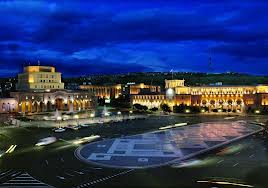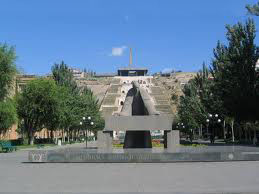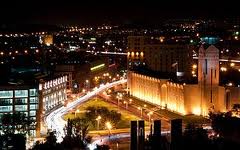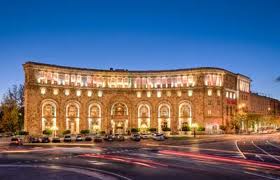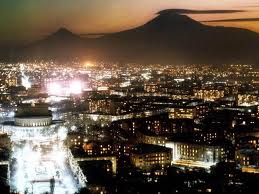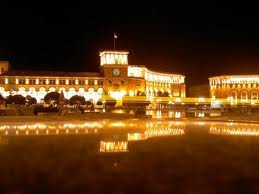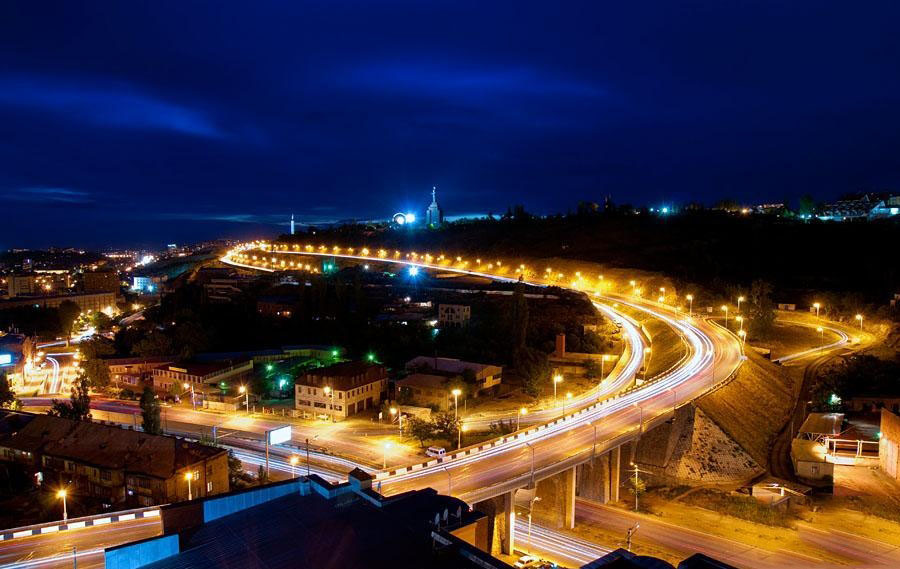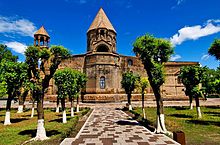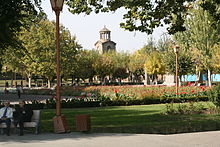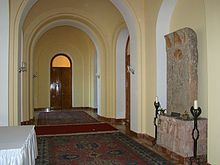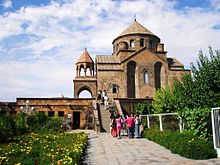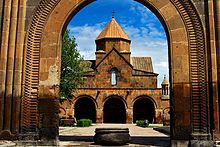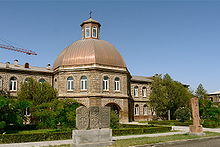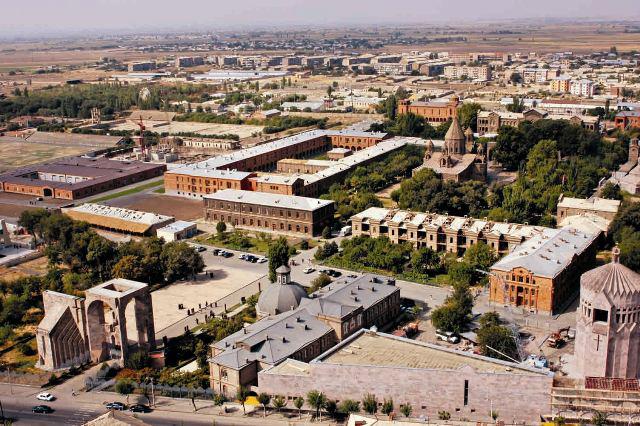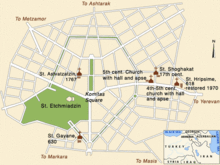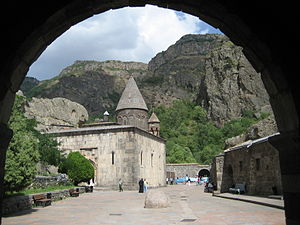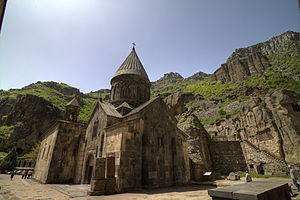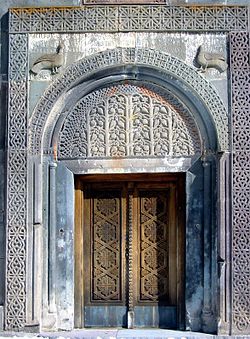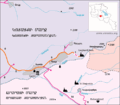Armenia
|
Capital: Yerevan
Official languages: Armenian
Government: Presidential republic
Legislature: National Assembly
|
Area: 29,743 km2
Population: 3,262,200
Currency: Dram (AMD)
Time zone: UTC (UTC+4)
|
Calling code: +374
Patron saint: St. Gregory the Illuminator
ISO 3166 code: AM
Elevation: 989.4 m (3,246.1 ft)
|
Yerevan
Yerevan, the capital of Armenia, is a modern, colorful city, situated in the Northeastern part of the Ararat Valley. Yerevan is one of the oldest cities in the world. It is 2780 years old.
Yerevan is a political, administrative, commercial and financial, as well as cultural and educational centre of Armenia. It occupies a territory of about 300 sq.km and its population is about 1.2 million.
Architecture of today's Yerevan combines the elements of past and present. According to the outstanding architect Alexander Tamanyan's design Yerevan has radial-circular arrangement. Many buildings, located at the central part of Yerevan, had been designed by Alexander Tamanyan. It's worth to mention an architectural complex of the Republic Square and the building of Opera and Ballet Theatre. The beautiful houses and buildings in Yerevan, constructed of basalt, marble, onyx, volcanic tuffa-stone, blend well with broad lines of the streets and avenues, green parks and vast squares. There are also a numerous fountains in Yerevan, that present you freshness in hot summer period.
A fans of history and culture can find many places of interest, such as museums, historic monuments and sites, art galleries, theatres, an opera and ballet theatre, concert halls. It is worth to mention the Matenadaran - one of the biggest world depositories of ancient illuminated manuscripts. Over 10000 manuscripts, written in Armenian, Greek, Latin, Arabic & other languages, are preserved here.
Etchmiadzin Cathedral
The Cathedral of S.Ejmiatsin was built in the 4th century and rebuilt in 480's. It is the seat of the Katholikos of the Armenian Church and is located in Vagharshapat, Republic of Armenia about 25 km from Yerevan. The Cathedral is part of a monastery having the same name and is surrounded by walls which enclose a series of structures. These structures include the Palace of the Katholikos, a seminary, museum, refectory, synod house, library, printing house, monks' cells, and other auxiliary buildings.
Armenia was the first country in the world to adopt Christianity as its state religion. Ejmiatsin is the residence of the Supreme Catholicos of all Armenians and the center of the Armenian Apostolic Church.
Garni Temple & Geghard
The actual building is a temple resting on an elevated podium and was most likely dedicated to the god Mihr. The entablature is supported by 24 Ionic columns resting on Attic bases. Unlike other Greco-Roman temples, it is made of basalt. The Garni Temple is comprised of buildings that date to the antique and medieval periods: a temple of Greco-Roman style built in Ionic order, a summer palace, a bath premise, and a cemetery; the round church was built in 897 AD. It has been proved that the temple was constructed in the 1st century AD by the King Tiridates I of Armenia. It is assumed that the king funded the construction with the money that he received from Emperor Nero during his visit to Rome.
Now Garni is a village in Kotayk Province of Armenia, some 35 km southeast of Yerevan.
Geghard is another incredible ancient Armenian monastery, partly carved out of a mountain. It was founded in the 4th century, according to tradition by St Gregory the Illuminator. The main cathedral was built in 1215. The monastery is located literally at the end of the road. The monastery of Geghard contains a number of churches and tombs, most of them cut into the rock, which illustrate the very peak of Armenian medieval architecture. The complex of medieval buildings is set into a landscape of great natural beauty, surrounded by towering cliffs at the entrance to the Azat Valley. The monastery of Geghard, with its remarkable rock-cut churches and tombs, is an exceptionally well preserved and complete example of medieval Armenian monastic architecture and decorative art, with many innovatory features which had a profound influence on subsequent developments in the region. The monastery was more famous because of the relics that it housed. The most celebrated of these was the spear which had wounded Christ on the Cross, allegedly brought there by the Apostle Thaddeus, from which comes its present name, Geghardavank (the Monastery of the Spear), first recorded in a document of 1250.
Geghard is another incredible ancient Armenian monastery, partly carved out of a mountain. It was founded in the 4th century, according to tradition by St Gregory the Illuminator. The main cathedral was built in 1215. The monastery is located literally at the end of the road. The monastery of Geghard contains a number of churches and tombs, most of them cut into the rock, which illustrate the very peak of Armenian medieval architecture. The complex of medieval buildings is set into a landscape of great natural beauty, surrounded by towering cliffs at the entrance to the Azat Valley. The monastery of Geghard, with its remarkable rock-cut churches and tombs, is an exceptionally well preserved and complete example of medieval Armenian monastic architecture and decorative art, with many innovatory features which had a profound influence on subsequent developments in the region. The monastery was more famous because of the relics that it housed. The most celebrated of these was the spear which had wounded Christ on the Cross, allegedly brought there by the Apostle Thaddeus, from which comes its present name, Geghardavank (the Monastery of the Spear), first recorded in a document of 1250.



